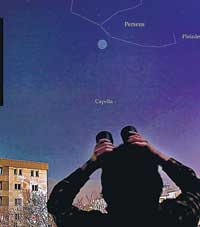
Comet Holmes beckons skygazers world wideAstronomers the world over have been stunned and amazed by the weirdest new comet to appear in the sky for a long time. And it's one of the brightest — easy to spot with your eyes alone, if you know where to look. Observers worldwide had no trouble spotting Comet Holmes through the full moonlight on the evening of October 25, 2007. Two days before, the periodic Comet Holmes (17P) brightened dramatically — by nearly a million times — virtually overnight. For comparison as seen from Earth, the Sun is about a million times brighter than the Full Moon. For no apparent reason, the comet erupted from a very dim magnitude 17 to about magnitude 2½. Within a day its star-like nucleus had expanded into a perfectly round, bright little disk visible through binoculars and telescopes. It looked like no comet ever seen.
Bad weather has prevented observation of the comet from Colombo as yet. Dr. Nalin Samarasinha, who is doing NASA supported research on comets at the National Optical Astronomy Observatory in Tucson, Arizona, USA has observed the comet for a week and informs us that it now about 8-12 arc minutes in diameter. That it is about 1/3 of the diameter of the Moon. The comet is likely to stay easily visible to the naked eye for at least a couple more weeks, before moonlight returns. The yellow colour is dust reflecting sunlight, as confirmed by the spectra that have been taken. Dust is what keeps a comet bright — as opposed to gas (comet gas is green and blue), which blows away quickly in the solar wind. Its startling outburst, however, has a precedent. The comet was also in a major eruption 115 years ago, in November 1892, when English amateur Edwin Holmes was the first to spot it. It reached 4th or 5th magnitude, faded in the following weeks, and then underwent a second eruption 2½ months after the first. Now, it seems, Comet Holmes has outdone itself. The first person to notice something happening this time was A. Henriquez Santana at Tenerife, Canary Islands, shortly after midnight on the morning of September 24th local time. The comet was then about 8th magnitude, but within minutes Ramon Naves and colleagues in Barcelona, Spain, caught it at magnitude 7.3.
The comet brightened to 2.8 and has remained about 3rd magnitude or brighter — shining as the third-brightest "star" in Perseus — while enlarging substantially. It's still a round, sharp-edged disk with a bright core when viewed through binoculars and telescopes. Look in the North Eastern sky after 8 p.m. on a clear night. Its position on November 3rd (0h UT) was right ascension 3h 43m, declination +50.6° (equinox 2000), and moving only slightly each day. On November +19–20 it will pass closely by Alpha Persei (by 1/3°). For skywatchers in the Northern Hemisphere, Perseus is visible all night around this time of year. The comet will stay in Perseus all the way into next March. Any tail will probably be short and stubby when, or if, it forms. The tail should be pointing nearly away from us in space — we're looking down its length — since the comet is nearly on the opposite side of Earth from the Sun. From the comet's viewpoint, the Earth and Sun are only about 14° apart, And this "phase angle" will stay small for many months. So we'll keep looking down the tail. |
|| Front
Page | News | Editorial | Columns | Sports | Plus | Financial
Times | International | Mirror | TV
Times | Funday
Times || |
| |
Reproduction of articles permitted when used without any alterations to contents and the source. |
© Copyright
2007 | Wijeya
Newspapers Ltd.Colombo. Sri Lanka. All Rights Reserved. |

